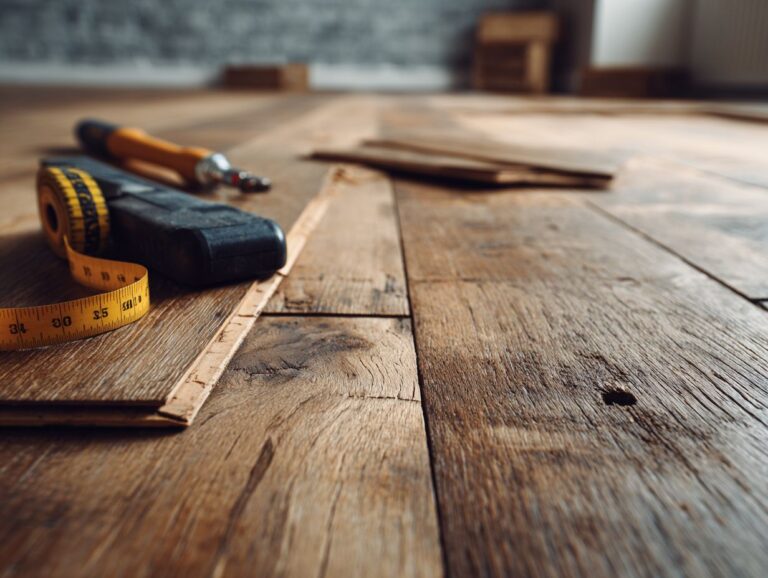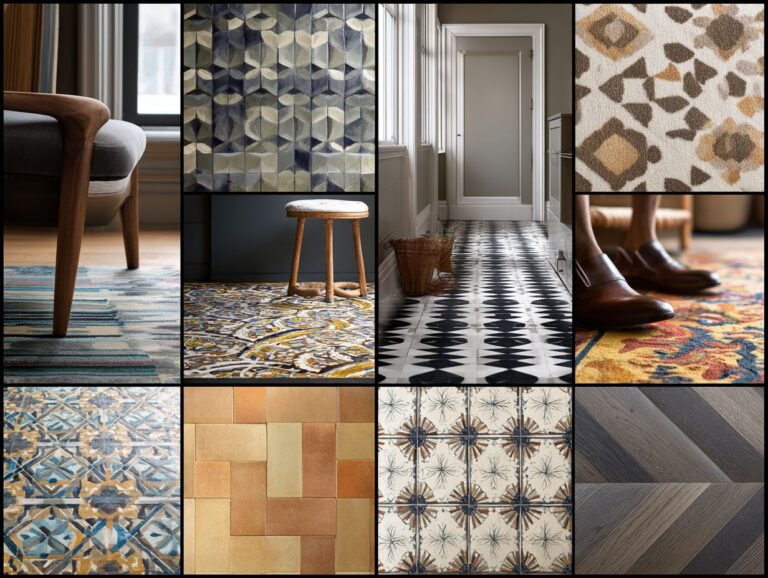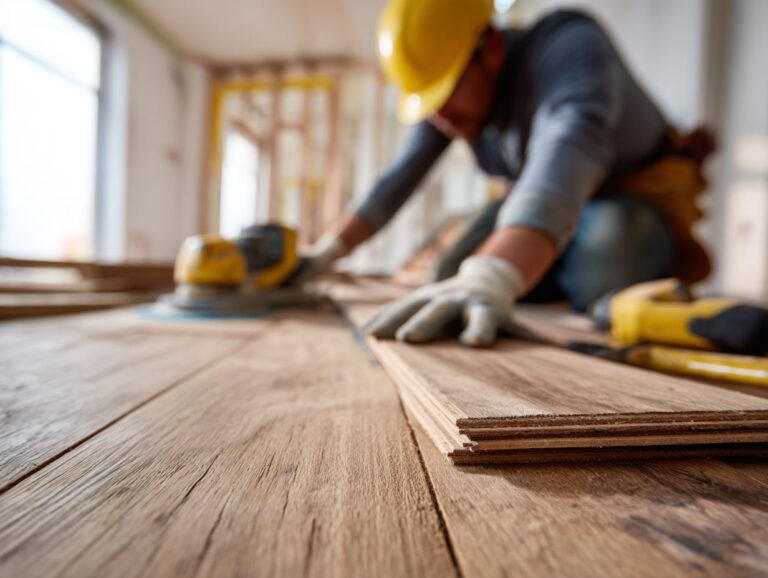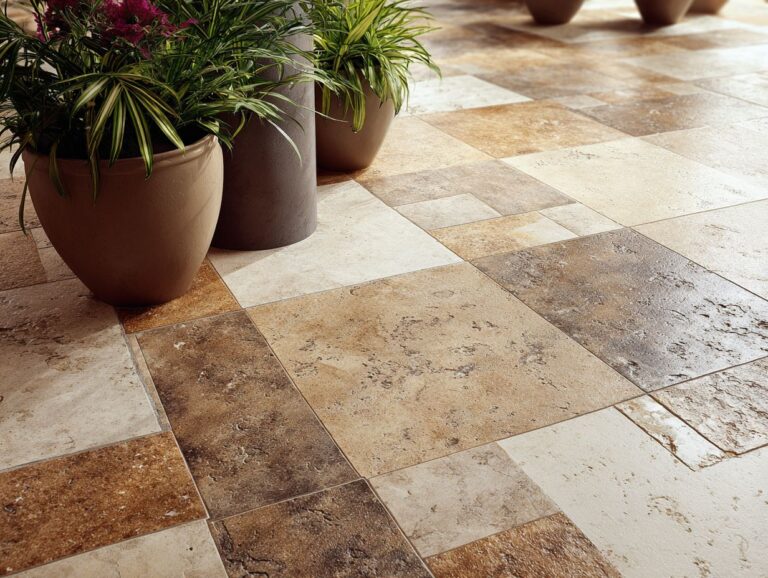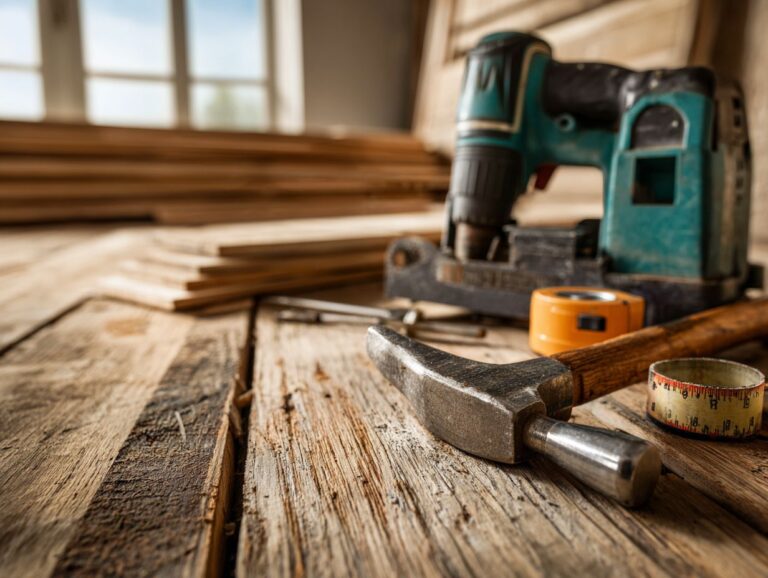Traditional Flooring Patterns – Timeless Designs
Contents
- Introduction to Traditional Flooring Patterns
- Classic Wood Flooring Patterns
- Tile Flooring Patterns
- Stone Flooring Patterns
- Carpet Flooring Patterns
- Combining Flooring Patterns
- Maintaining Traditional Flooring
- Flooring Trends and Popularity Statistics
- Frequently Asked Questions
- What are traditional flooring patterns and why are they considered timeless designs?
- What are some examples of traditional flooring patterns?
- What makes traditional flooring patterns a great choice for any home?
- Are traditional flooring patterns difficult to install?
- How can you use traditional flooring styles in a modern home?
- What are the benefits of choosing traditional flooring patterns over modern designs?
Introduction to Traditional Flooring Patterns
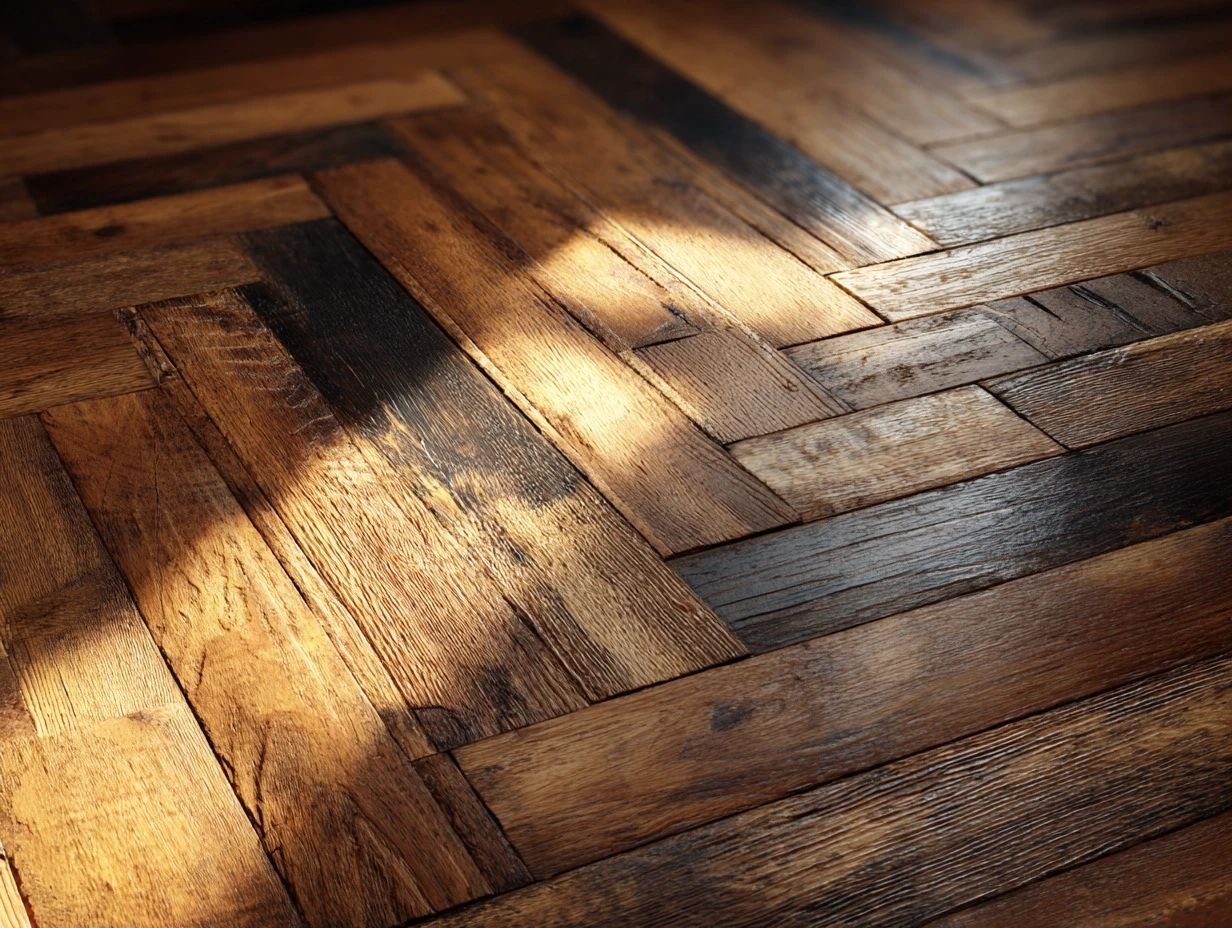
Key Takeaways:
The Importance of Flooring in Interior Design
The flooring is an important part of interior design, influencing the atmosphere and functionality of a room.
The type of flooring you choose can significantly improve or worsen how a room looks. For instance, hardwood flooring adds warmth and can increase a home’s value by approximately 2.5%, while trendy patterned tiles can create visual interest in smaller areas, like kitchens or bathrooms.
Incorporating a consistent color palette across flooring and furniture can establish a cohesive look. To get the most out of your investment, think about using engineered wood in busy areas for its strength, or look at luxury vinyl as a cost-effective and attractive alternative. This approach aligns with the principles outlined in our guide to flooring scale and proportion, helping ensure your flooring choices complement the overall design.
Overview of Traditional Flooring Materials
Traditional flooring encompasses a variety of materials, each offering unique characteristics and aesthetics to complement diverse design styles.
Key materials include:
- Hardwood
- Tile
- Carpet
Each historically significant in Victorian and colonial homes.
Hardwood, such as warm oak, adds richness and warmth, often found in grand parlors and dining rooms. Tile, with its durability and ornate designs, features prominently in kitchens and bathrooms, reflecting the era’s emphasis on functionality.
Carpet, particularly plush options, was used in bedrooms and sitting areas for comfort and luxury. Every material is important and contributes to the home’s design style and historical context.
For those interested in how flooring choices affect property values, Realtor insights on the flooring impact on home sale price offer valuable perspectives.
Classic Wood Flooring Patterns
Traditional wood flooring designs offer a timeless look, highlighting skillful work and adding a cozy feel to any indoor area.
Herringbone Pattern
The herringbone pattern, characterized by its zigzag design, is a hallmark of traditional flooring that adds visual interest and depth.
To install herringbone flooring using 2×4 inch boards, start by measuring your space to determine how many boards you’ll need.
Use a miter saw for accurate angle cuts and a flooring nailer to fasten the boards securely.
Begin your layout by marking guidelines on the subfloor, ensuring the pattern remains symmetrical. For example, in a Victorian-style home, aligning the design with the current architectural features can make it feel more authentic.
This project typically requires a weekend, allowing time for acclimation of the boards and careful installation.
Chevron Pattern
Chevron flooring features a V-shaped layout that offers a modern twist on classic designs, perfect for mid-century modern aesthetics.
In contrast, herringbone flooring creates a zigzag pattern by arranging rectangular planks in a staggered formation. The methods for installing these patterns are different.
- Cheron needs careful cutting at 45-degree angles for a smooth look.
- Herringbone can be installed with simple cuts, which is somewhat easier.
As for materials, both styles can be achieved with hardwood, laminate, or even tile. The chevron pattern works well in contemporary dining or living areas, while the herringbone design adds a cozy, traditional touch, ideal for welcoming hallways or country-style kitchens.
Plank Flooring
Plank flooring delivers a rustic yet timeless appeal, available in a variety of finishes and widths to suit various interior styles.
Wider planks, usually between 6 to 12 inches, make a room feel bigger and improve its look. Species like oak provide durability and a warm tone, while maple offers a lighter, contemporary feel.
To maintain these floors, regular sweeping and occasional damp mopping are essential. Applying a quality wood finish every few years will maintain the appearance of the planks and protect them from scratches.
Following these tips keeps your flooring looking great for many years.
Tile Flooring Patterns
Tile flooring patterns are strong and look nice, so they are often chosen for both classic and contemporary homes. For an extensive analysis of design options, including the pros and cons of various surface textures, our deep dive into textured vs smooth flooring offers valuable insights.
Subway Tile Layouts
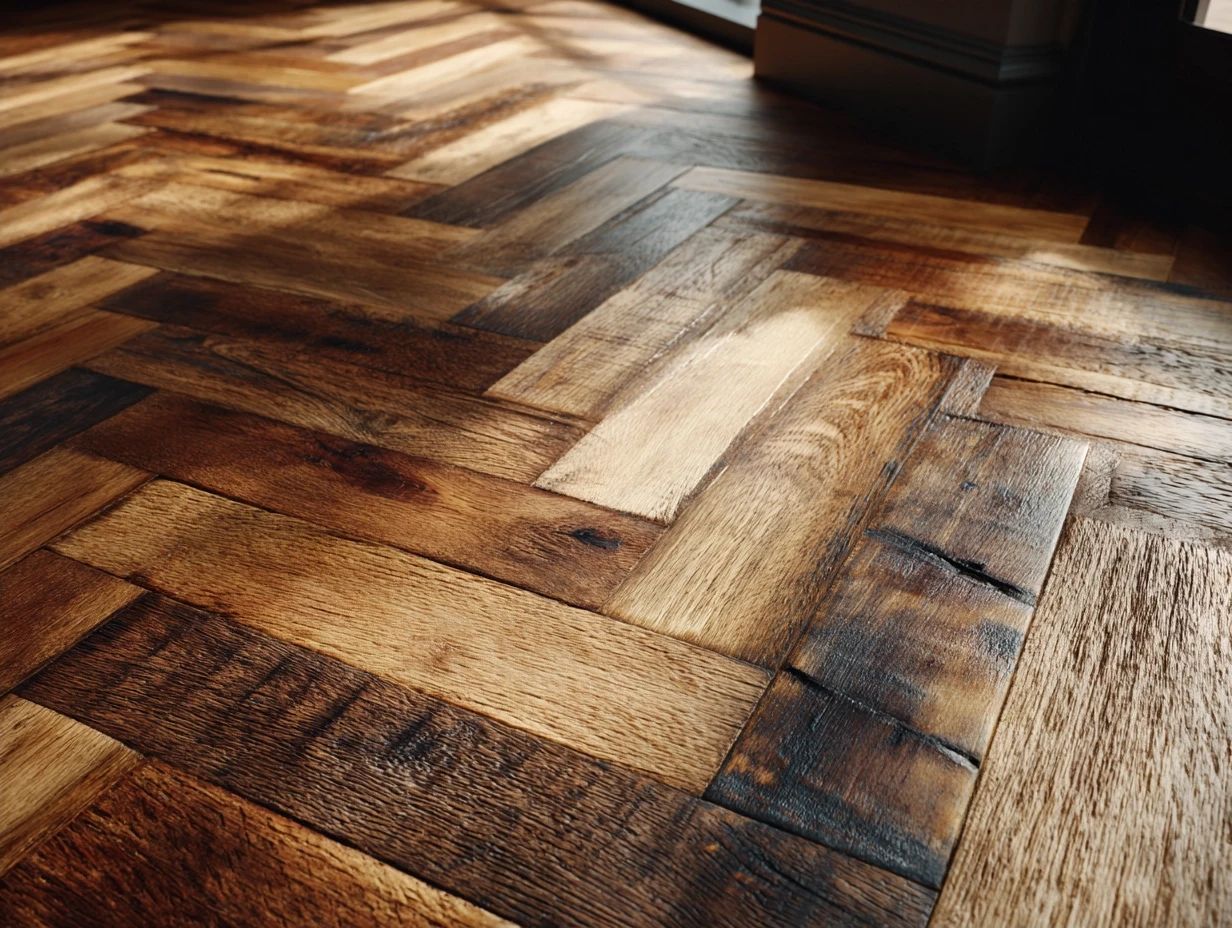
Subway tiles, known for their rectangular shape, offer a clean and timeless look that complements various design styles, especially in kitchens and bathrooms.
To install subway tiles, start by preparing the surface with a clean, flat base. Apply a layer of thin-set mortar using a notched trowel, then place the tiles, spacing them evenly with tile spacers.
For grout, consider using colors like soft gray or classic white for a smooth appearance, while a strong black can provide a striking contrast.
Historically, these tiles flourished in Victorian homes, adding elegance and durability to spaces. Modern interpretations can still echo this charm while fitting contemporary aesthetics.
Basketweave Design
The basketweave design combines small tiles to create a woven effect, adding texture and charm to spaces like bathrooms and entryways.
- To install basketweave tiles, begin by getting the surface ready; make sure it’s clean, dry, and even.
- Next, apply thin-set mortar using a notched trowel to create a strong bond. Begin laying tiles from the center, pressing each piece into the mortar, and use spacers to maintain even gaps.
- This design originated in ancient Rome, and now uses glass and porcelain to be stronger and more stylish.
- Seal the installation with grout to prevent water damage, especially in moisture-prone areas.
Diagonal Tile Patterns
Diagonal tile patterns can create the illusion of larger rooms and hallways, making them a common option for compact spaces.
To install diagonal tiles, start by ensuring your subfloor is clean and level. Use a tile cutter or a wet saw to make exact cuts at 45-degree angles.
Arrange your tiles on the floor before sticking them down to see how the pattern will look. Use different colors like dark blue and white to bring out a classic style.
As you set the tiles, employ spacers to maintain even gaps for grout. Review each phase carefully to achieve the best results.
Stone Flooring Patterns
Stone flooring patterns provide long-lasting strength and a natural look that adds to the classic charm of any home.
Random Ashlar Pattern
The random ashlar pattern showcases irregularly shaped stones, creating a rustic and organic feel, perfect for outdoor spaces.
To install a random ashlar pattern, start by clearing the area and ensuring a solid base.
Lay out your stones in a dry fit to visualize the design, then choose a mortar suitable for your climate.
For colonial-style homes, consider using locally sourced stone to maintain historical integrity.
The installation shows the skill of early American colonists, who used these patterns to build strong paths and foundation walls. This method improves your outdoor space and brings a touch of history to it.
Flagstone Layout
Flagstone layouts create a natural and inviting atmosphere, ideal for patios and walkways while providing enduring quality.
To install flagstone effectively, start by preparing a solid substrate. Excavate the area to a depth of about 4-6 inches, ensuring proper drainage.
Next, lay a gravel base, compacting it tightly. Use a mixture of sand and cement as a leveling layer before placing the flagstones.
For grouting, opt for a sand and polymer blend, which allows for flexibility and reduces weed growth.
Successful outdoor projects typically include edges or borders to keep stones in place and improve the look, as shown in many DIY landscaping galleries online.
Carpet Flooring Patterns
Carpet patterns add warmth and comfort, making them a favorite for cozy areas in traditional homes.
Berber Carpet Styles
Berber carpet styles, known for their looped texture, provide durability and a cozy atmosphere, ideal for high-traffic areas.
They are particularly popular among families, with 25% of homeowners opting for Berber due to its stain resistance and ease of maintenance.
To install, consider both glue and stretch-in methods; the choice depends on the subfloor type. Regular vacuuming and occasional professional cleaning keep the texture looking fresh.
When selecting a Berber carpet, look for options made from nylon or wool for added durability. A quality Berber carpet, which lasts 10 to 15 years, can significantly improve the comfort of your home.
Geometric Patterns in Carpeting
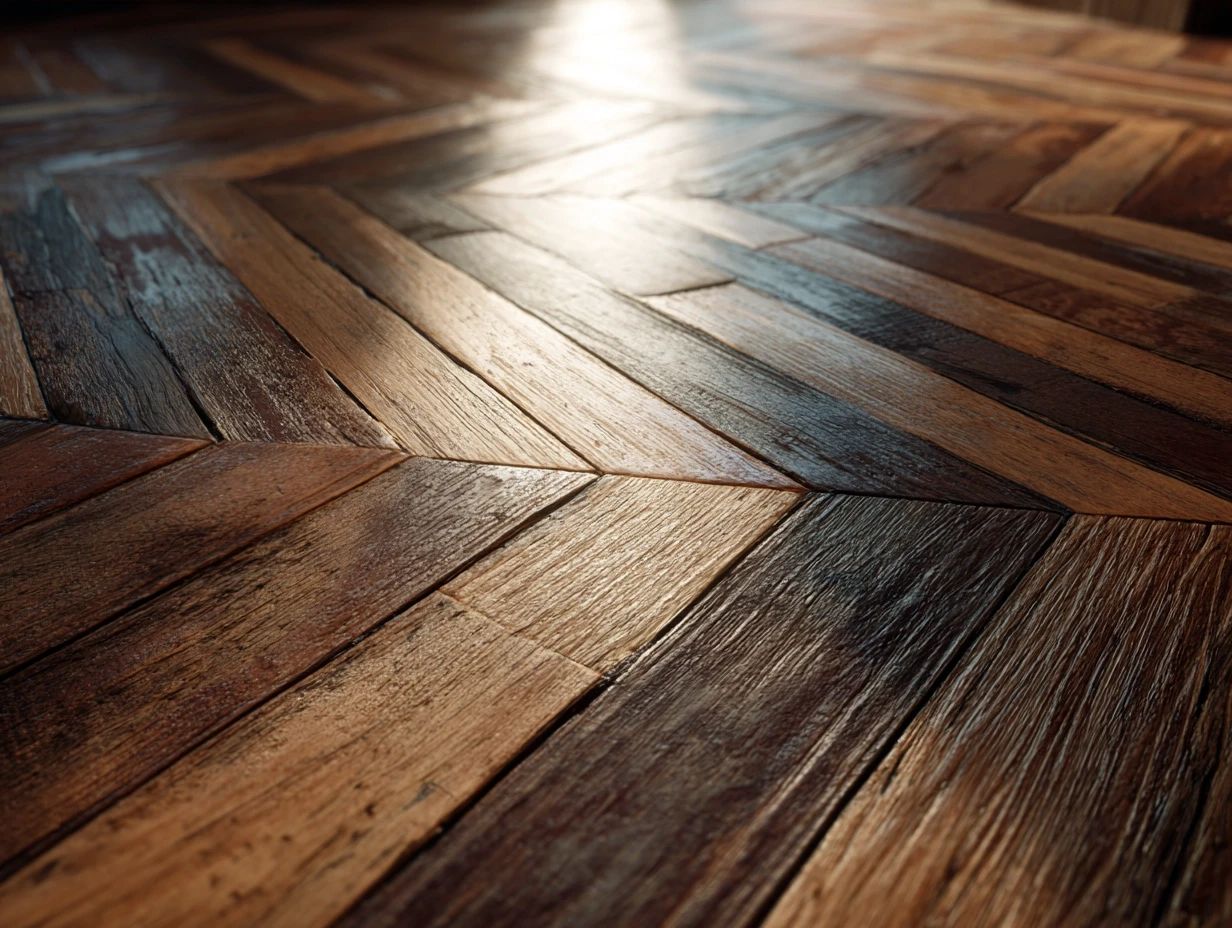
Geometric patterns in carpeting add a modern flair while maintaining the warmth and charm of traditional dcor.
To use geometric carpets well, think about patterns like chevrons, diamonds, or hexagons in colors such as rust, mustard, or deep teal.
These patterns can be placed in living rooms to create focal points or used in entryways for a welcoming atmosphere.
To set it up, hire an expert for correct positioning and tightness, especially with complicated designs.
A well-placed geometric rug can define spaces and contrast beautifully with vintage furniture, enhancing the overall aesthetic while providing comfort and warmth underfoot.
Combining Flooring Patterns
Mixing flooring designs gives you the chance to show your creativity, smoothly joining various materials to improve the look of your home. Those curious about how varied designs can transform compact living spaces might appreciate our insights on Loft and Studio Apartment Flooring Ideas.
Mixing Wood and Tile
Mixing wood and tile flooring can create a sophisticated transition between spaces, adding depth and contrast to interiors.
To achieve a harmonious blend, consider using wood in living areas for warmth and tile in high-traffic zones like kitchens or bathrooms for durability.
For example, a herringbone wood pattern can flow into a large porcelain tile in a contrasting color. Space the two materials with a thin transition strip to maintain clean lines, or use grout lines to visually separate them, ensuring a cohesive look.
In a recent design, a light oak was paired with sleek gray tiles, enhancing both style and functionality.
Layering Textures
Using different flooring textures adds visual interest and makes a home feel more welcoming.
One effective technique is to place a plush area rug over hardwood floors. For example, a soft, neutral-toned rug can create a cozy zone in a living area, contrasting beautifully with the hard surface beneath.
Consider varying sizes; a large rug anchors furniture, while smaller ones can define separate spaces, like a reading nook.
To improve this layered design, use rugs with various textures-consider jute for a natural appearance combined with a velvety throw rug. This brings more layers and makes your home decor feel cozy.
Maintaining Traditional Flooring
Maintaining regular flooring patterns increases their lifespan and appearance, enabling homeowners to protect their investment.
Cleaning and Care Tips
Cleaning and maintaining floors correctly can make them last longer. Use different methods depending on the type of material.
-
To clean hardwood floors, use a neutral pH cleaner like Bona. Apply it every 1-2 weeks to prevent residue buildup and keep the surface shiny.
-
Clean your tile weekly with a gentle ceramic cleaner. To clean grout, scrub it with a mix of baking soda and water every month.
-
Carpet requires specific care; vacuum it at least twice a week, and use a steam cleaner to remove stains every 6-12 months.
These routines will help preserve the integrity and appearance of your flooring.
Restoration Techniques for Vintage Floors
Restoring vintage floors requires specialized techniques that respect their historical significance while bringing them back to life.
For hardwood floors, sanding is essential to remove years of wear and tear. Start with a coarse sandpaper (40-grit) and work your way to a finer grit (120), ensuring a smooth finish.
To make tile floors look good again and stop any damage, you might need to re-grout them. Use a grout saw to take out the old grout, then apply new grout with a float.
A case study in a 1920s home revealed significant improvement using these methods, where labor costs amounted to $1,200 but resulted in a 30% increase in home value.
Upcoming Changes in Classic Flooring Styles
Emerging trends in traditional flooring designs are increasingly embracing sustainable materials and innovative patterns that complement classic aesthetics.
Experts predict that eco-friendly options like bamboo and reclaimed wood will dominate the market. These materials reduce harm to the environment and are also strong.
Designers are increasingly using updated versions of traditional herringbone and chevron patterns. They are mixing different textures and using bright colors to achieve new styles. For instance, using eco-friendly cork in a herringbone design adds both warmth and soundproofing benefits.
As consumers become more environmentally conscious, flooring solutions balancing tradition with innovation will continue to flourish. One of our hidden gems on flooring innovation discusses the importance of Sound Transmission Class (STC) ratings for selecting materials that enhance both aesthetic and functional value.
Flooring Trends and Popularity Statistics
Flooring Trends and Popularity Statistics
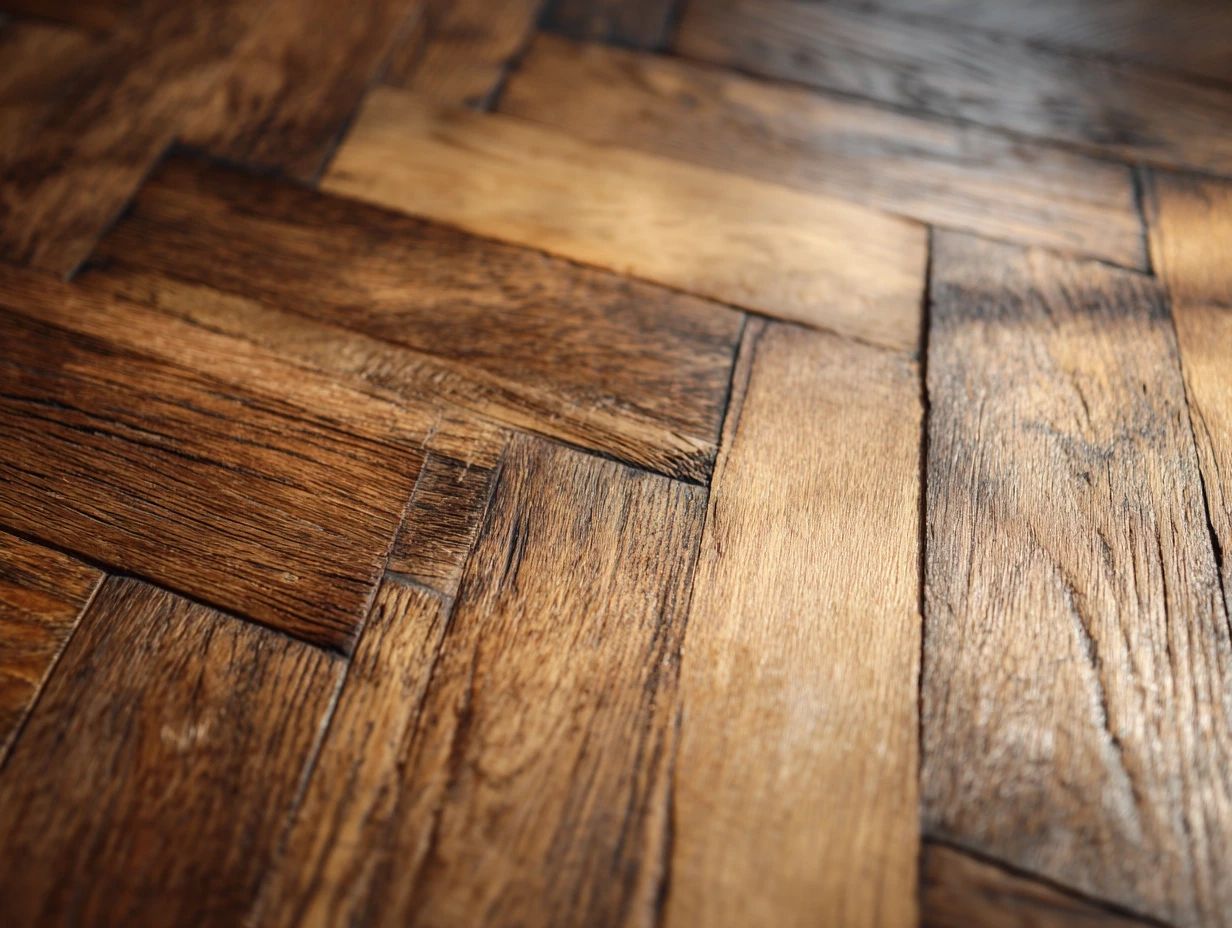
Traditional Flooring Popularity: Sustainability and Health
The data set, titled Flooring Trends and Popularity Statistics, offers information about the current focus on sustainability and health in the flooring industry, looking closely at traditional flooring choices. This reflects broader consumer trends towards environmentally friendly and health-conscious home improvement choices.
Traditional Flooring Popularity highlights the growing importance of responsible manufacturing and indoor air quality. Both metrics are rated at a perfect score of 100, demonstrating the industry’s commitment to these aspects:
- Responsible Manufacturing: A score of 100 indicates that traditional flooring manufacturers are increasingly adopting sustainable practices. This includes using eco-friendly materials, reducing waste during production, and ensuring ethical sourcing of raw materials. Such practices are critical in minimizing environmental impact and appealing to eco-conscious consumers.
- FloorScore Indoor Air Quality: Also rated at 100%, this metric signifies that traditional flooring options are being designed to meet high standards of indoor air quality. FloorScore certification is a trusted indicator for ensuring that flooring products contribute to healthier indoor environments by limiting volatile organic compounds (VOCs) and other pollutants.
The focus on responsible manufacturing and indoor air quality indicates a shift in consumer priorities, with health and environmental impact becoming key factors in purchasing decisions. As a result, flooring manufacturers are responding by enhancing their sustainability credentials and ensuring that their products are safe for indoor environments.
In summary, the Flooring Trends and Popularity Statistics Recent data shows that the flooring industry is focusing on sustainability and health trends. By getting top scores in responsible production and indoor air quality, traditional flooring manufacturers are meeting and possibly surpassing what consumers want, putting themselves in a good spot in a tough market.
Frequently Asked Questions
What are traditional flooring patterns and why are they considered timeless designs?
Traditional flooring patterns refer to designs and layouts that have been used for centuries and have stood the test of time. They are considered timeless because they have remained popular and relevant despite changing design trends.
What are some examples of traditional flooring patterns?
Some popular traditional flooring patterns include herringbone, parquet, and chevron. These patterns are commonly found in hardwood, tile, and stone flooring.
What makes traditional flooring patterns a great choice for any home?
Traditional flooring patterns work well with any home design. They make a room feel cozy and welcoming, adding personality and warmth.
Are traditional flooring patterns difficult to install?
The difficulty of installation depends on the type of material used. Some hardwood floors have complex designs that might need a professional to install. However, those who are skilled in DIY projects can install tile or stone floors themselves.
How can you use traditional flooring styles in a modern home?
A great way to use traditional flooring designs in a modern home is by combining new and old styles. This can be achieved by pairing a traditional pattern with sleek and modern furniture or accessories.
What are the benefits of choosing traditional flooring patterns over modern designs?
Some benefits of traditional flooring patterns include their durability, timelessness, and ability to add character to a space. They can also increase the value of a home and are a great investment for long-term use.
